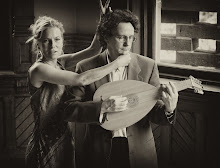The program and notes for our concert Sat. Nov. 16, 2013, 8PM Heliconian Hall 35 Hazelton Ave., Toronto. Tickets $25 and $20 at the door
The Fame Which Posterity Gives – John Dowland (1563-1626)
 |
| A trompe-l'œil ceiling from one of the King of Denmark's castles about the time Dowland worked for him. Might that lute player be the only picture of Dowland? |
Famam, posterias quam dedit Orpheo
Dolandi melius Musica dat sibi
‘The fame which posterity gives to Orpheus/To Dowland, Music gives the better’ Thomas Campion
Preludium
A Shepheard in a shade his plaining made
Dye not beefore thy day
His golden locks time hath to silver turnde
.jpg) |
| Sir Henry Lee with locks neither golden nor silver |
Sir John Smith his Almaine
It was a time when silly Bees could speake
If my complaints could passions move
Lachrimae
The Right Honourable the Lady Rich, her Galliard
Flow my tears
Times eldest sonne: First part/Then sit thee downe: Second part/When others sings Venite exultemus: Third part
Intermission
Thou mightie God/When Davids life by Saul/When the poore Criple
The Battell Galliard
Frog Galliard
 |
| Duc d'Alençon, whom Elizabeth strung along for a great while |
Lady if you so spight me
Sorrow sorrow stay, lend true repentant teares
Sweet stay awhile, why will you rise?
Fantasie
In darknesse let mee dwell
Program Notes
‘My Lord of Essex chose to evaporate his thoughts in a sonnet (beeing his common way) to be sung before the Queene, (as it was) by one Hales, in whose voice she took some pleasure.’ Sir Henry Wotton wrote this some 40 years after the execution of Robert Devereaux, the Earl of Essex, in a pamphlet comparing him to another spectacular courtier who met an untimely end, the Duke of Buckingham, the ‘favourite’ of James I. But it would be very rare, even impossible, for Essex and Elizabeth to ever be alone together; court ceremony meant that the ensemble called the Lutes and Voices served right in the Queen’s bed chamber along with all the other courtiers and servants. So any courtier’s poem sung before the queen and her entourage was very much a semi-public, self-serving self-fashioning. This is most explicit in Dowland’s setting of Essex’s poem ‘It was a time when silly Bees could speak’, called 'The Earl of Essex, his Buzz’ in poetic sources, where Essex, punning heavily on thyme/time, complains to the queen bee that he is not getting his just reward for all the time he puts in getting nectar from the thyme.
 |
| The Earl of Essex, head intact |
 |
| Lucy, Countess of Bedford, bankroller of Jacobethan Melancholy |
 |
| A Melancholy Man, by Isaac Oliver, sometimes said to be Philip Sidney |



No comments:
Post a Comment